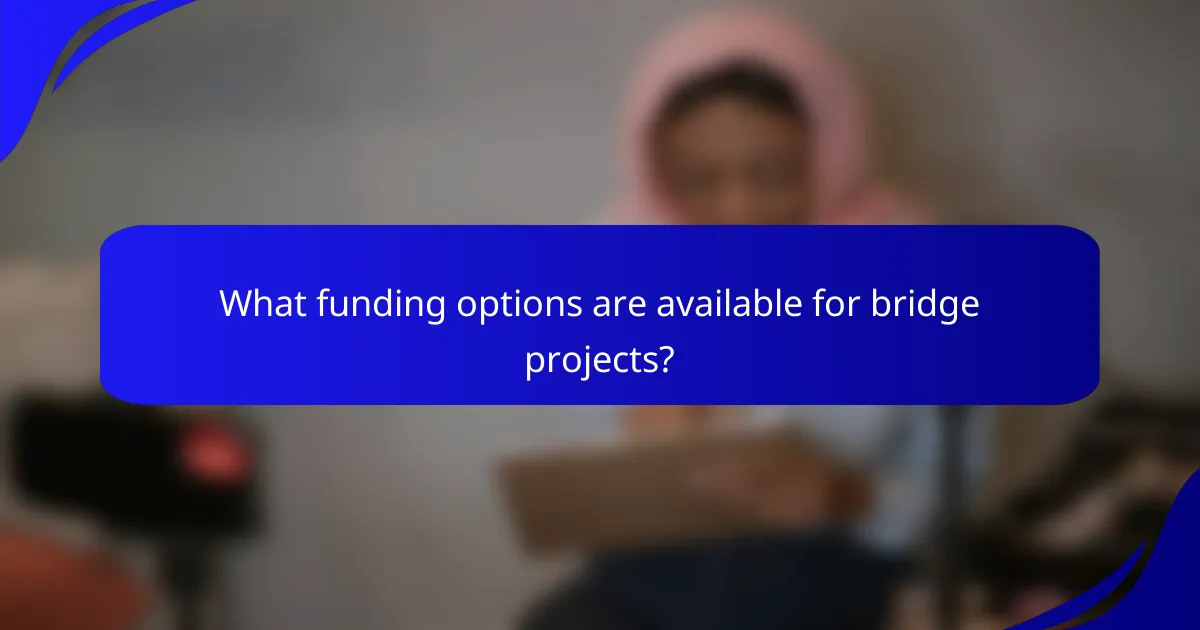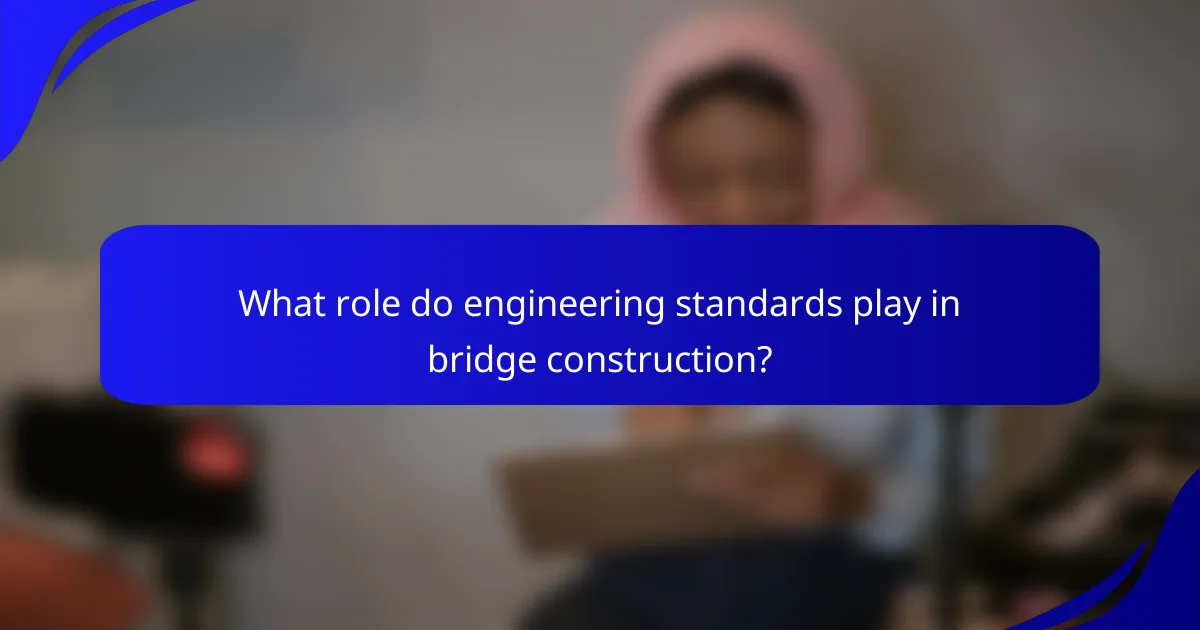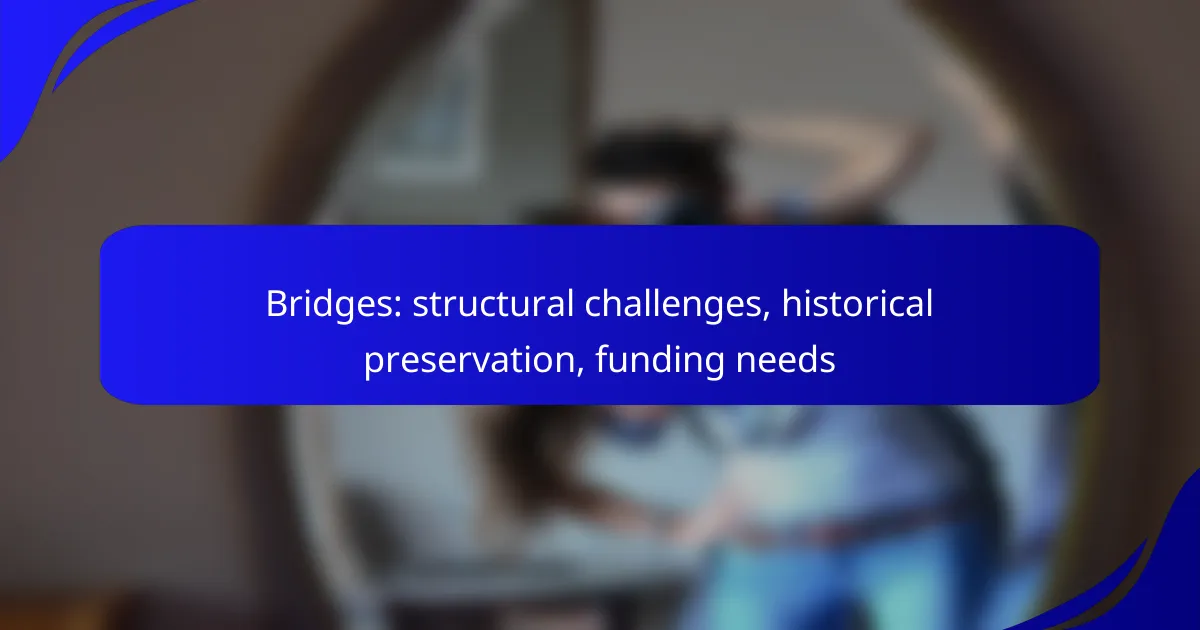Bridges are vital infrastructure that face numerous structural challenges, such as material degradation and load capacity issues, which can jeopardize safety and longevity. Additionally, the preservation of historical bridges requires a blend of restoration techniques and community engagement to maintain their integrity while adapting to contemporary needs. Funding for bridge projects can come from diverse sources, including government grants and public-private partnerships, each presenting unique advantages and challenges for successful execution.

What are the structural challenges of bridges in Australia?
Bridges in Australia face several structural challenges, including material degradation, load capacity issues, and environmental impacts. These factors can compromise safety and longevity, necessitating careful management and investment in maintenance and upgrades.
Material degradation
Material degradation is a significant challenge for bridges, primarily due to exposure to harsh weather conditions and environmental pollutants. Common materials like steel and concrete can corrode or crack over time, leading to structural weaknesses.
Regular inspections and maintenance are essential to identify signs of degradation early. Implementing protective coatings and using corrosion-resistant materials can help extend the lifespan of bridge structures.
Load capacity issues
Load capacity issues arise when bridges are subjected to traffic loads that exceed their designed limits. Increased vehicle sizes and volumes, along with aging infrastructure, can lead to overloading, which poses safety risks.
To address load capacity concerns, engineers often conduct load rating assessments to determine a bridge’s current capabilities. Reinforcement or retrofitting may be necessary to ensure that bridges can safely accommodate modern traffic demands.
Environmental impact
The environmental impact of bridges includes potential disruptions to local ecosystems and waterways. Construction and maintenance activities can lead to habitat loss and pollution if not managed properly.
Mitigation strategies, such as using environmentally friendly materials and implementing erosion control measures, are crucial. Additionally, conducting environmental assessments before construction can help minimize adverse effects on the surrounding environment.

How can historical bridges be preserved?
Preserving historical bridges involves a combination of restoration techniques, adaptive reuse strategies, and community involvement. These approaches ensure that the structural integrity and historical significance of the bridges are maintained while also addressing modern needs.
Restoration techniques
Restoration techniques for historical bridges often include structural repairs, surface cleaning, and the use of traditional materials that match the original construction. Techniques such as epoxy injection for cracks and the careful replacement of deteriorated elements help maintain the bridge’s integrity without compromising its historical value.
It is essential to follow preservation standards, such as those set by the National Park Service in the U.S., which emphasize minimal intervention and the use of reversible methods. Regular inspections can help identify issues early, allowing for timely restoration efforts.
Adaptive reuse strategies
Adaptive reuse strategies transform historical bridges for new purposes while preserving their character. For instance, a bridge can be converted into a pedestrian walkway or a public park, enhancing community access and engagement. This approach not only preserves the structure but also revitalizes the surrounding area.
When considering adaptive reuse, it is crucial to evaluate the bridge’s structural capacity and ensure compliance with local regulations. Engaging with architects and engineers experienced in historical preservation can help identify feasible reuse options that respect the bridge’s heritage.
Community involvement
Community involvement is vital for the preservation of historical bridges. Local advocacy groups can raise awareness, organize funding efforts, and foster public interest in maintaining these structures. Engaging the community through educational programs and volunteer opportunities can strengthen local ties to the bridge.
Additionally, involving community members in decision-making processes ensures that preservation efforts align with public interests. Fundraising events, such as bridge walks or festivals, can also generate financial support while promoting appreciation for the historical significance of the bridge.

What funding options are available for bridge projects?
Bridge projects can be funded through various sources, including government grants, public-private partnerships, and crowdfunding initiatives. Each option has its own advantages and considerations that can impact project feasibility and execution.
Government grants
Government grants are a primary source of funding for bridge projects, often provided by federal, state, or local agencies. These grants typically require a detailed proposal outlining the project’s scope, budget, and expected outcomes.
Eligibility for government grants can vary significantly, so it’s essential to research specific programs that align with the project’s goals. For instance, the Federal Highway Administration offers grants that can cover a substantial portion of construction costs, sometimes up to 80% for eligible projects.
Public-private partnerships
Public-private partnerships (PPPs) involve collaboration between government entities and private companies to fund and manage bridge projects. This approach can leverage private investment while sharing risks and responsibilities.
PPPs can take various forms, such as design-build contracts or revenue-sharing agreements. It’s crucial to establish clear terms and expectations to ensure that both parties benefit and that public interests are safeguarded throughout the project lifecycle.
Crowdfunding initiatives
Crowdfunding initiatives allow individuals and organizations to raise small amounts of money from a large number of people, typically via online platforms. This method can be particularly effective for community-driven bridge projects that aim to enhance local infrastructure.
Successful crowdfunding campaigns often require a compelling narrative and clear goals to engage potential backers. It’s important to promote the project effectively and communicate how contributions will directly impact the community, potentially offering rewards or recognition for donors.

What are the best practices for bridge maintenance?
The best practices for bridge maintenance include regular inspections, preventive repairs, and the use of technology to monitor structural integrity. These practices help ensure safety, extend the lifespan of the bridge, and reduce long-term costs.
Regular inspections
Regular inspections are crucial for identifying potential issues before they become serious problems. Inspections should be conducted at least annually, but more frequent checks may be necessary in areas with harsh weather conditions or heavy traffic.
During inspections, look for signs of wear, such as cracks, rust, or misalignment. Documenting findings helps prioritize repairs and track changes over time.
Preventive repairs
Preventive repairs involve addressing minor issues before they escalate into major repairs. This can include sealing cracks, replacing worn components, and applying protective coatings to prevent corrosion.
Establish a maintenance schedule that aligns with inspection findings. For example, if a bridge shows signs of rust, schedule repairs within a few months to prevent further damage.
Use of technology
The use of technology in bridge maintenance enhances monitoring and assessment capabilities. Tools like drones and sensors can provide real-time data on structural health, allowing for more accurate inspections.
Consider implementing a digital management system to track maintenance activities, inspection results, and repair schedules. This can streamline processes and improve decision-making regarding funding and resource allocation.

How do climate change and natural disasters affect bridges?
Climate change and natural disasters significantly impact bridges by increasing their vulnerability to extreme weather events and altering environmental conditions. These factors can lead to accelerated deterioration, necessitating urgent assessments and upgrades to ensure safety and functionality.
Increased flooding risk
Bridges are often at risk from rising water levels and increased flooding due to climate change. Floodwaters can erode foundations, damage structural components, and disrupt access. Regular monitoring and maintenance are essential to identify vulnerable bridges and implement protective measures.
In flood-prone areas, engineers may consider elevating bridge designs or using materials that withstand prolonged exposure to water. Communities should also develop emergency response plans to manage bridge safety during severe weather events.
Structural integrity concerns
Natural disasters such as earthquakes and hurricanes can compromise the structural integrity of bridges. These events may cause cracks, shifts, or complete failures, highlighting the need for robust design standards that account for potential seismic or wind loads.
Routine inspections and assessments are crucial for identifying wear and damage. Implementing retrofitting techniques can enhance resilience, ensuring bridges can withstand future natural disasters without significant repairs.
Long-term planning needs
Addressing the impacts of climate change and natural disasters on bridges requires long-term planning and investment. Infrastructure agencies must prioritize funding for upgrades and maintenance to adapt to changing environmental conditions.
Incorporating climate resilience into bridge design and construction practices can mitigate risks. Stakeholders should engage in collaborative planning efforts to secure funding and develop strategies that enhance the longevity and safety of bridge infrastructure.

What role do engineering standards play in bridge construction?
Engineering standards are crucial in bridge construction as they ensure safety, reliability, and structural integrity. These standards provide guidelines for materials, design, and construction practices, helping engineers create bridges that can withstand various loads and environmental conditions.
Key engineering standards for bridges
Several key engineering standards guide bridge construction, including the American Association of State Highway and Transportation Officials (AASHTO) specifications and the Eurocode in Europe. These standards cover aspects such as load calculations, material specifications, and design methodologies, ensuring that bridges meet safety and performance criteria.
For example, AASHTO’s LRFD (Load and Resistance Factor Design) approach helps engineers account for uncertainties in loads and material strengths, promoting safer designs. Adhering to these standards minimizes risks associated with structural failures and enhances the longevity of the bridge.
Importance of compliance with local regulations
Compliance with local regulations is essential in bridge construction, as these regulations often reflect regional environmental conditions and safety concerns. Local authorities may have specific requirements regarding materials, design, and construction practices that align with the area’s unique challenges.
For instance, bridges in seismic zones must adhere to stricter standards to ensure they can withstand earthquakes. Understanding and integrating these local regulations into the design process is vital for successful bridge projects.
Challenges in meeting engineering standards
Meeting engineering standards can present challenges, particularly in terms of cost and material availability. High-quality materials that comply with standards may be more expensive, impacting project budgets. Additionally, sourcing these materials can be difficult in certain regions, leading to delays.
Another challenge is the need for skilled labor familiar with these standards. Ensuring that construction teams are adequately trained and knowledgeable about the latest engineering practices is crucial for maintaining compliance and achieving desired outcomes.
